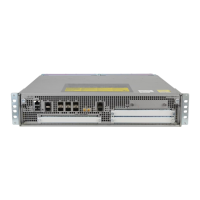Implementing Multicast Routing on Cisco IOS XR Software Cisco ASR 9000 Series Routers
How to Implement Multicast Routing
MCC-54
Multicast Configuration Guide
OL-
SUMMARY STEPS
1. configure
2. vrf source-vrf
3. address-family {ipv4 | ipv6} unicast
Note Only IPv4 addressing is currently supported for extranet.
4. import route-target [xx.yy:nn | as-number:nn | ip-address:nn]
5. export route-target [xx.yy:nn | as-number:nn | ip-address:nn]
6. end
or
commit
7. configure
8. vrf receiver-vrf
9. Repeat steps 3. through 6.
DETAIL STEPS
Command or Action Purpose
Step 1
configure
Example:
RP/0/0/CPU0:router# configure
Enters global configuration mode.
Step 2
vrf source-vrf
Example:
RP/0/0/CPU0:router(config)# vrf green
RP/0/0/CPU0:router(config-vrf)#
Configures a VRF instance for the source PE router.
Step 3
address-family [ipv4 | ipv6} unicast
Example:
RP/0/0/CPU0:router(config-vrf)# address-family
ipv4 unicast
Specifies a unicast IPv4 or IPv6 address family and enters
address family configuration submode.
Note Only IPv4 addressing is supported for extranet.
Step 4
import route-target [xx.yy:nn | as-number:nn |
ip-address:nn]
Example:
RP/0/RP0/CPU0:router(config-vrf-af)# import
route-target 234:222
Example:
RP/0/0/CPU0:router(config-vrf-af)# import
route-target 100:100
Imports the selected route target, optionally expressed as
one of the following :
• 4-byte AS number of the route target in xx.yy:nn
format. Range is 0-65535.0-65535:0-65535
• AS number of the route target in nn format. Range is
0-65535.
• IP address of the route target in A.B.C.D. format.

